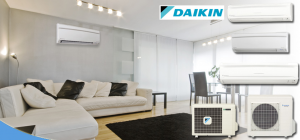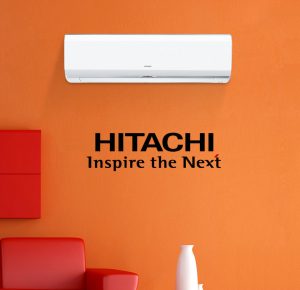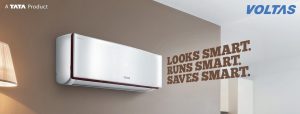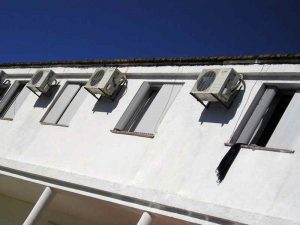Latest Air Conditioner Technologies in India – Review 2024
- Latest AC Technologies
- Ubiquitous Sensor Network for Smart Cooling
- App Control of ACs using the Smartphone
- 4D Airflow with Wider Angle and Larger Fan
- Fast Cooling Technologies that Quickly Cools the Room
- Humidity Control using Auto Humid Control and Dry Mode
- PM 2.5, PM 1 and Anti-VOC Filters
- Auto Clean with iClean, Blow Clean and iCleanser
- Copper Condenser and Anti-Corrosive Hydrophilic Blue Fin
- Dual Inverter Technology with Acoustic Jacket
- Protection from Voltage Fluctuations, Refrigerant Leakages, Corrosion and Fire
- Conclusion
The scorching summers have arrived and if you are looking to buy a new AC or want to keep abreast with the latest development in the AC tech world you must definitely read this article. Air conditioner industry has seen a significant change over last few years. Indian AC market has witnessed a healthy double-digit growth in the recent years and if the analyst believe same growth rate would continue for few more years to come. Once considered a luxury, ACs are now perceived as an essential appliance even in the middle and low-income families. Given tropical Indian climate with temperatures soaring as high as 50oC it is imperative to use a robust technology and components which would empower ACs to deliver comfort cooling during the peak summers. Why only summers modern state-of-the-art ACs are capable of delivering optimum climate control even during heavy downpours and bone-chilling winters. In this article we will steer through the technologies which is making all these possible.
- Latest AC Technologies
- Ubiquitous Sensor Network for Smart Cooling
- App Control of ACs using the Smartphone
- 4D Airflow with Wider Angle and Larger Fan
- Fast Cooling Technologies that Quickly Cools the Room
- Humidity Control using Auto Humid Control and Dry Mode
- PM 2.5, PM 1 and Anti-VOC Filters
- Auto Clean with iClean, Blow Clean and iCleanser
- Copper Condenser and Anti-Corrosive Hydrophilic Blue Fin
- Dual Inverter Technology with Acoustic Jacket
- Protection from Voltage Fluctuations, Refrigerant Leakages, Corrosion and Fire
- Conclusion
Latest AC Technologies
Ubiquitous Sensor Network for Smart Cooling
Developments in the field of electronics, have made the usage of variegated sensors cinch for heavy electrical appliances. Most of the top AC brands use assorted mix of sensors and sensor technologies to impart smart cooling. Hitachi uses revolutionary iSee technology which comes in the new Hitachi models (e.g Kashikoi series). These models come with an intelligent image sensor technology ensure that the users inside the room get an equal attention for an equal cooling comfort while minimizing the wastage of cooling. The image sensor detects number of people in the room, their location, their activity etc and then cools accordingly to ensure maximum cooling comfort. It also recognizes the shape and size of the room and then regulates its swing angle with a special smart swing feature in a bid to optimize cooling. Another important feature is it also recognizes human absence in the room for a specified time and switches the AC off automatically to avoid cooling wastage. Taking cues from Hitachi, even the new Daikin ACs come with a smart human sensor that detects human presence (and their count) to optimally cool the room.
Similarly, modern Carrier ACs comes with a Follow Me feature wherein there is a sensor placed inside the remote. When this feature is enabled, main room sensor inside the indoor unit takes the back seat, and the specialized sensor inside the remote gets activated. Based on the information received from this remote sensor, the AC adjust the ambient temperature. This sensor is capable of gathering temperature information even about the farthest parts of the room, and then passing the same to the main unit, thereby ensuring the optimum temperature throughout the room. Following the footsteps of the foreign brands, Blue Star ACs too come with 5 different sensors to deliver what they call Precise Cooling Technology (PCT). PCT mandates Blue Star ACs to adjust the temperature with the precision level of 0.1oC.
App Control of ACs using the Smartphone
With the growth of smartphone, flurry of apps, millennials want an app for everything; even for controlling their AC. The AC manufacturers have fulfilled this demand by developing a smart dedicated app to control the AC. Here too Hitachi leads the pack with WiFi Connect technology which additionally comes with WiFi Direct functionality. The user simply needs to download the dedicated Hitachi app and pair it with a router. Once the connection is established, the user can control and monitor their AC from any part of the room. The best part is, even if router or WiFi network is not present, one can still connect the smartphone (even the tablet) with the AC using WiFi Direct feature.
Whirlpool ACs too come with app control feature. The best part about Whirlpool app is that it also gives estimated energy consumption based on the usage. Also, app provides a graphical representation of the usage, so users have a better idea how many units of energy their AC is guzzling. Even if the AC don’t come with inbuilt app-based control, if your phone has a IR blaster, almost any AC can be controlled using the smartphone without the need to download manufacturer-specific dedicated app.
4D Airflow with Wider Angle and Larger Fan
Conventional ACs come with 2-way (up and down) swing blade to disseminate cool air inside the room. But most of the new ACs from brands like LG, Hitachi, BlueStar, Carrier etc come with the 4D swing function (up-down + right-left) which blows the cool air in multiple directions to ensure thorough cooling inside the room. This 4D swing is designed with a motorized horizontal and vertical swing utility that ensures uniform cooling across the room via an omnidirectional air flow mechanism.
The louvers of Blue Star ACs come with a wider angle to ensure the even distribution of cool air inside the room without omitting the far-flung corners of the room. Similarly, the louvres of the FTKP series of Daikin ACs open upwards known as Coanda airflow. This means the cold air would not directly hit the people, something which users will surely find useful. The Coanda airflow provides draftless, pleasant air-conditioning in the entire room. To compliment the 4D air swing new split ACs from LG comes with larger fan and body which increases the airflow and spread it up to 30 feet. As a result, every corner of the room is nearly as cool as the area in front of the AC blade.
Fast Cooling Technologies that Quickly Cools the Room
There is lot of buzz around ‘fast-charging’ technology when it comes to smartphone, fast cooling technology in the AC finds similar reception amongst the HVAC enthusiasts. Manufacturers adopts various techniques and designs to cool the room in a jiffy.
Inspired from the ambience in the Himalayas, new models from LG comes with Himalaya Cool technology that replicate hill station feel of the Himalayas at the home itself. There is a dedicated button to enable this mode labeled as HCOOL on the remote. When enabled, AC would throw cool air at a super-high speed for around 30 minutes, till the temperature of the room is brought down to a comfortably cool level. With the Himalaya Cool technology, LG ACs deliver faster cooling without compromising on the energy saving aspect. Daikin comes with a Power Chill mode with dual flap flattening to quickly cool the room within 20 minutes.
Whirlpool AC uses 3D Cool Extreme and dual fan compressor to deliver what they call Turbo Cool. The 3D Cool Extreme technology uses 3 vents system—one at top and two sideways to pull out the hot air at a faster rate. Premium Whirlpool models come with dual fan compressor which compliment 3D Cool Extreme technology and boost the performance of the AC so that it can rapidly cool the room even in the intense temperature as high as 55oC.
Humidity Control using Auto Humid Control and Dry Mode
Summer season makes the AC overwork and with the monsoon to follow, ordinary ACs could fail to control the humidity or even result in water leakage. During the rainy season, conventional air conditioners not only consume more energy but also make the room uncomfortably cold. This may lead to health ailments like sneezing, common cold or even headache. Most of the new AC models from reputed brands like LG, Voltas, Bluestar, Carrier etc comes with a dehumidification or dry mode to keep the humidity under control.
Hitachi is one step ahead of its competitor in this department. Apart from the dry mode, high-end models of Hitachi ACs come with Auto Humid Control technology wherein the temperature and humidity profile of over 100 cities is fed inside the processor of ACs. Based on the data it adjusts the air conditioning and when it detects the high humidity the refrigerant cycle is expedited to extract humidity out of the room. Thus, with the help of dry/dehumidification mode, modern ACs deliver dry, clean and fresh air without any stickiness inside the room. In humid regions, especially across the vast coastline of India, this feature in ACs is indispensable.
PM 2.5, PM 1 and Anti-VOC Filters
Filter is one of the important battleground for the AC brands to innovate. Reason being the rising level of air impurity. According to WHO (World Health Organization) levels of air pollution have tremendously increased in the developing economies especially in India. Lately, air pollution has been linked to an increased in respiratory diseases like lung cancer. The risk due to particulate type pollution is said to be similar to what is seen with second-hand smoke exposure. So, air filtration becomes one of the very important aspect of the AC and the manufacturers keep coming with innovation and techniques to control the rising levels of air impurity by using multi-layer filters.
Particulate matter, PM 2.5 consist of very fine particles present in the air which are of the size two and a half microns in width (or even less). Micron is unit of measurement at a microscopic scale with one-inch equating to 25,000 microns. Emission from vehicles alongside the burning of wood and oil are the primary sources of PM 2.5 particulates. Modern ACs from reputed brands like Whirlpool and Carrier comes with PM 2.5 filter to filter out PM 2.5 impurities from the room. But LG steps ahead of Whirlpool and Carrier as they additionally offer PM 1 filters—filtration of particle of size 10,000 microns or less. Furthermore, 2018 onwards ACs from LG would come with a special Ocean Black Protection, tactfully applied to both indoor & outdoor unit. This would empower ACs to deliver optimum cooling in the tropical Indian climate heavily affected by sand, salt, industrial smoke & pollutants.
Volatile Organic compounds (VOCs) are organic compounds that easily become vapors or gases owing to their high vapor pressure at room temperature. Typical sources of VOCs are burning of fuel like gasoline, wood, coal, natural gas, etc. The residues from paints, glues, and solvents also add to the concentration of VOC in the air. Many VOCs are hazardous because when combined with nitrogen oxides, they react with them forming ground-level ozone, or smog, which leads to climate change. Certain VOCs are infamous for impacting liver, kidney and nervous system. Midea ACs come with an anti-VOC filter for removal of volatile organic compounds (VOC). Anti-VOC filter used in Midea split ACs eliminates toxic VOCs like formaldehyde to ensure air is debarred of such impurities.
Blue Star takes a slightly eccentric route when it comes to filtration. Premium Blue Star models comes with a cold plasma technology which generates a natural bioclimate in the AC. Being rich in active positive and negative ions of hydrogen and oxygen they form ionic bonds with harmful bacteria and other airborne agents like spores from the mold, ultimately to nullify them. These bonded particles gradually increase in size which makes it easier to be trapped by the arrangement of 7 formidable filters working in sync.
Auto Clean with iClean, Blow Clean and iCleanser
Filters are an important component of ACs, and if ignored it could drastically reduce the cooling capacity. In fact, according to the studies an AC which is run daily for 6 months without cleaning and maintenance, it’s cooling capacity can diminish by up to 50%. In the fast-paced world, we often forget to clean and maintain our AC at regular intervals. But off late AC manufacture have designed a solution for this pestering problem. Apart from the usual robust air filtration and purification premium ACs from top rated brands like LG, Hitachi, BlueStar, Carrier comes with an auto clean functionality wherein AC cleans its own filter using various techniques and methods.
Hitachi ACs featuring iClean function come with an innovative brush that moves on the stainless steel plated filter from one side to the other by sweeping the dust along the wing. A dedicated dust box is provided which collects the dust particles swept by the brush. This auto cleaning barely takes 5-7 minutes to complete. Once the cleaning is done the brush moves back to its initial position. Similarly, Blue Star ACs come with Blow Clean mode, wherein the indoor blower runs for a few minutes after switching off the air conditioner. This assists in auto cleaning and helps to keep the indoor coil dry, preventing accumulation of dust or mold.
Besides the impeccable air filtration technology, premium Carrier models come with iCleanser technology which cleanses itself. During this auto cleaning, first the indoor unit operates in a cooling mode at a reduced fan speed, to facilitate removal of dust from evaporator fins. Then it switches to fan-only mode to blow away the wet air, disinfecting indoor unit. The main USP of premium Carrier air conditioner is that there is an additional cleaning and replacement notifier that alerts the user when there is a need for manual cleaning of the filter if the dust collected exceeds the ambit of iCleanser cleaning.
Copper Condenser and Anti-Corrosive Hydrophilic Blue Fin
To save cost and bring down the AC prices many AC manufacturers preferred using aluminum condenser in most of their models in the past. Aluminum condenser is cheaper than the copper condenser but tend to get corroded faster. Also, it’s very difficult to repair an aluminum condenser and it mostly needs a complete replacement; which means the repair charges would be pretty high. Lot of AC brands specially the Indian ones like Voltas, BlueStar, Godrej have received lot of flakes for bringing most of their models with aluminum condensers. With the increased level of consumer awareness, many users only prefer to buy AC with copper condenser. So now brands are bringing more and more models with copper condenser seeing the rise in the predilection for copper condenser. Japanese and Chinese brands like Hitachi, Daikin and Haier offer only copper condenser in their latest models.
Here too Hitachi leads the rest as everything: copper tube condenser, evaporator & interconnecting pipes in the newer models are made 100% of copper. Additionally, high-end models like Toushi comes with inner grooved copper which helps in quick and optimum refrigeration flow. When it comes to LG, they have reworked on its aluminum condenser besides bringing plethora of models with copper condenser. Improved version of aluminum condenser in the form of specialized aluminum alloy with lesser propensity for corrosion is being used in newer models from LG.
When it comes to heat exchanger, modern AC models from reputed brands like Voltas, Carrier, Daikin, Hitachi, BlueStar come with an anti-corrosive hydrophilic blue fin on the outdoor of the heat exchanger. Usage of anti-corrosive hydrophilic blue fin increases the wettability of the heat exchanger and provides better protection from corrosion. This arrangement ensures rapid removal of condensate from the indoor unit. This, in turn, deters the breeding/formation of mold and bacteria which can impact the performance of the AC and purity of the transuded air. People living in the region with high humidity will find this addition very useful to safeguard their AC from corrosive elements and to extend the AC’s life in general.
Dual Inverter Technology with Acoustic Jacket
Digital Inverter technology is arguably the most important innovation, pushing the boundaries of air conditioner technology. For decades, ACs had single-speed compressors that were always either on or off. A compressor is an engine that powers the air-conditioning cycle, moving refrigerant through the arrangement of condenser, compressor, and evaporator. With a single-speed compressor, when the temperature inside the room reaches above a certain temperature, the compressor suddenly switches on – a familiar noise for those who own an AC from the 20th century. But the concept of the inverter has completely changed the dynamics of AC (and refrigeration) industry.
So, what is an inverter technology? Well, to be really simple, inverter technology is analogous to the car accelerator. When compressor needs more power, it gives it more power. When it needs less power, it gives less power. With this technology, the compressor is always on but draws less power or more power depending on the temperature of the incoming air and the level set in the thermostat. The speed and power of the compressor is adjusted appropriately.
LG, BlueStar and Hitachi fares the best when it comes to inverter technology. That’s because they have adopted dual inverter technology compared to the ordinary single inverter technology. 2018 series of LG ACs are powered with revolutionary DualCool technology. With an increased operating frequency range, this dual inverter compressor technology gives LG an upper hand over its competitors in terms of cooling efficiency. Compared to the conventional inverter, dual inverter-based AC comes with an advanced BLDC motor with a wider range of frequency helping it to maintain the desired temperature with minimal fluctuations. Dual inverter ACs uses variable tonnage technology. So ACs with DualCool technology coming with 1.5 ton capacity can vary the tonnage from as low 0.26 ton to as high as 1.71 ton according to the ambient conditions and the user requirement.
To counter DualCool technology from LG, Hitachi’s ACs come with an expandable tropical inverter ACs uses Seamless Cascade Vector DC Inverter System. To improve coefficient of performance in full load as well as part load conditions, Hitachi has also introduced a new concept called Dual Flow Expansion Technology (DFET). All these additions in the Hitachi’s tropical inverter compressor optimizes peak performance to give perfect cooling even in the extreme temperatures of 52oC. Thanks to DFET technology ACs makes more than half of the AC sales for Hitachi—a share which is pretty high, compared to the usual 20-25%.
On a similar lines Blue Star AC comes with dual rotor inverter compressor powered by BLDC motor. An advanced BLDC motor is used to impart high rotational speed with minimal vibrations. Additionally, an acoustic jacket is provided with the compressor to mitigate the sound levels. Thus, this technology results in faster cooling, reduced vibration, low noise, and longer durability of the compressor.
Protection from Voltage Fluctuations, Refrigerant Leakages, Corrosion and Fire
There are various factors and phenomenon which may hamper the functioning of AC. For example: power cuts, refrigerant leaks, corrosive environment, short circuit etc. Protecting AC from the scourges of such factors is critical. Therefore, AC companies have worked in the area of security and protection to safeguard the ACs from any untoward accidents or mishaps.
Power cuts and load shedding is commonplace in India, especially in distant towns and villages. ACs being a big electrical appliance are most susceptible to vagaries of the supplied electricity. Power cuts generally poise the problem of a voltage fluctuation which can damage the air conditioner. ACs from premium brands like Daikin, LG and Whirlpool are capable of tackling this problem, thanks to their stabilizer-free operation functionality.Premium Whirlpool ACs come with a smart voltage compensation logic which works as a mini stabilizer, to ensure smooth functioning of the AC in the range of 155V to 264V, while the Daikin split ACs can operate in the range of 160V to 264V without the stabilizer. LG leads the pack here as it protect the AC over a much wider range—145V to 290V.
Improper installation, factory defect or external damage can cause refrigerant inside the AC to leak out. Refrigerant like Freon are toxic and if deeply inhaled it can cut off the supply of oxygen to the cells and lungs. Newer Carrier models comes with a vigilant early warning system that detects such leakage immediately and turns off the AC. Simultaneously, it also displays the relevant error code on the display to apprise the users about the leakage. LG on the other hand has developed the technology which would detect refrigerant levels and would notify the user if there is need to refill the refrigerant.
Outdoor units of the Blue Star split ACs have been built keeping in mind the harsh tropical Indian climate. They use galvanized steel in the construction of the metal bodies and are then further coated with polyester powder paint. This protects them from corrosion and increases their life.
Control box of ACs are susceptible to fire due to excessive flow of electricity or short-circuiting. Thus following the high safety and precautionary standards, modern Whirlpool split ACs come with a metal shell with a fireproof case for the control box to avert any fire mishap. On the similar lines Blue Star air conditioners come with a metal enclosure which covers the main board—the PCB (printed circuit board) to prevent overheating of electronic/electrical components.
Conclusion
Taking the advantage of the latest research and discoveries, modern ACs come with the state-of-art technologies and components to deliver comfort cooling. Japanese and Korean brands like Hitachi, Daikin and LG are the vanguard of AC technologies and have done away with obsolete and environmentally unfriendly technologies. Like LG have stopped producing non-inverter ACs, Daikin has ceased from using R22 refrigerant and Hitachi don’t use aluminum condenser.
Modern ACs provide “air conditioning” in a true sense all year round. Be it cooling during scorching summers, dehumidifying during heavy downpours or heating during bone-chilling winters, new 2-in-1 (Hot & Cold) ACs serves as a reliable companion across weathers. High-end ACs come with smart sensors which detects when someone is actually in the room and adjusts automatically to save on energy. 4D airflow in the ACs imparts uniform cooling without being concentrated only in the line of air swing. Stabilizer-free operation and auto-restart shields the AC from vagaries of power cut and makes sure AC resumes with its operation smoothly after the power cut without hampering the pre-set settings. Inverter technology makes sure the ACs deliver the optimum cooling. With the dual rotary inverters, precision level of 0.1oC is reached in the premium Blue Star ACs.
With the rising urbanization and technological innovation, air quality is becoming one of the major concern, especially in the big cities. Keeping this in mind established AC manufacturers arm their ACs with advanced filters to clean the air from all types of pollutants, bacteria, viruses, dust particles, and foul odors using an impeccable arrangement of multi-layer filters working in tandem. Finally, for the tech-savvy users, premium models boast of app control feature that gives them the liberty to manage AC simply by swiping the phone.
About the Author:
Hussain Kanchwala is an Electronics Engineer from University of Mumbai. As an Analyst at BijliBachao he keeps a tab on latest technologies in gadgets and appliances, tracks businesses of white goods companies and monitors the consumer behavior. With a background in engineering, penchant for detail, and flair for writing he regularly write reviews about brands and their products. More from this author.






